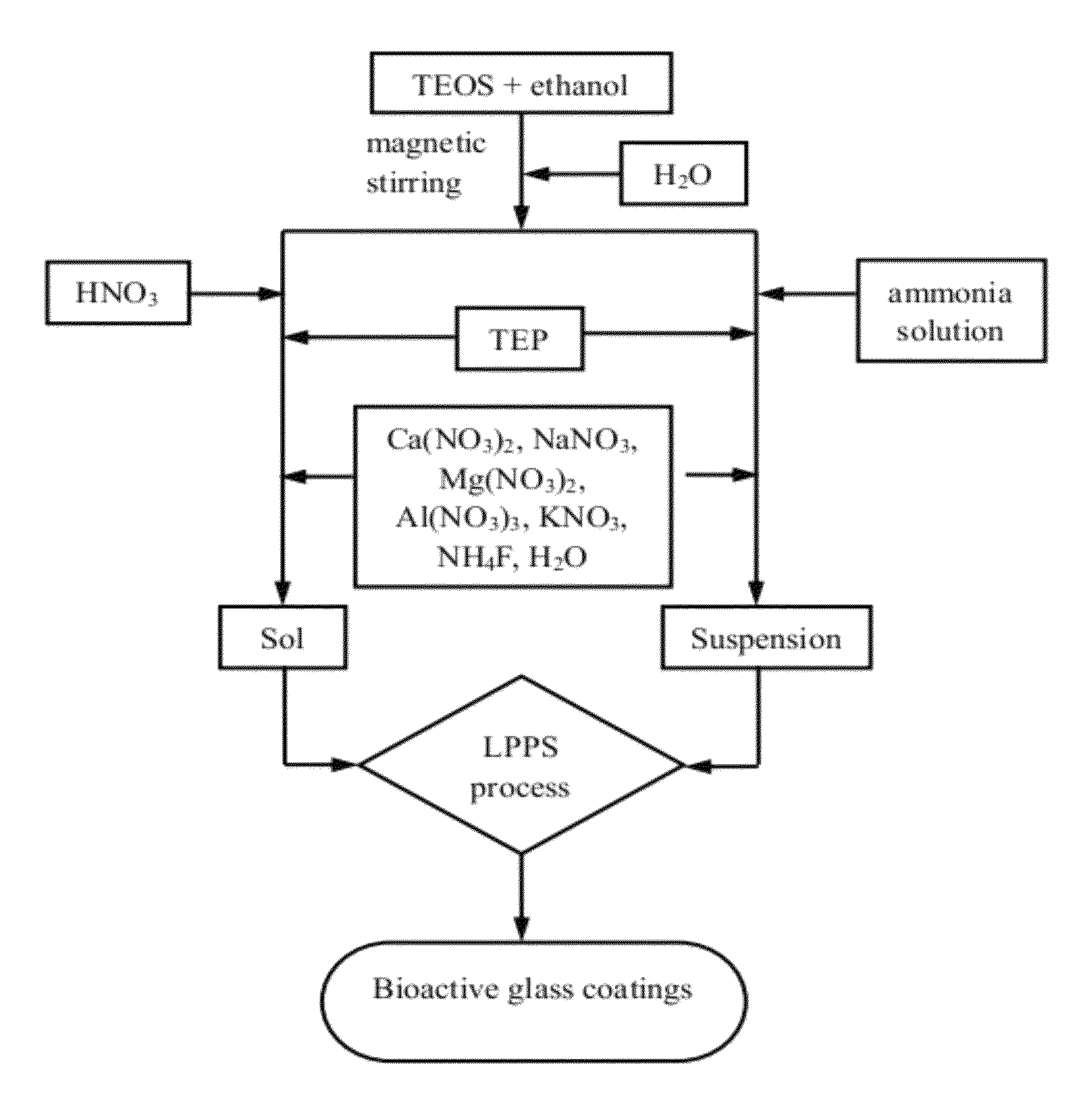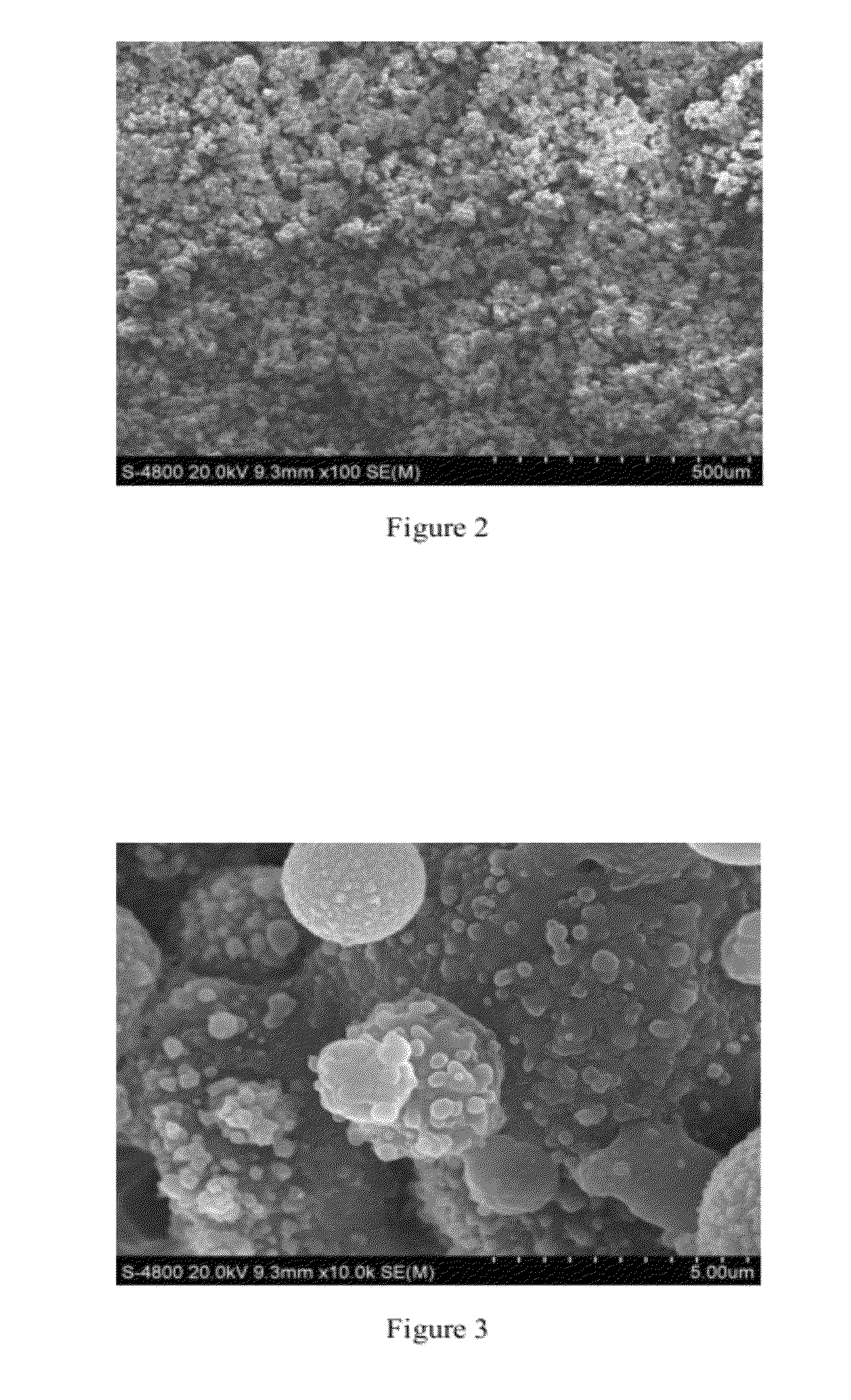Method for preparation of bioactive glass coatings by liquid precursor thermal spray
a technology of bioactive glass and thermal spray, which is applied in the field of biomedical materials, can solve the problems of limiting their use, affecting the mechanical properties of bioactive glass, and high brittleness and low toughness, and achieves high purity, not cracks, and high bonding strength
- Summary
- Abstract
- Description
- Claims
- Application Information
AI Technical Summary
Benefits of technology
Problems solved by technology
Method used
Image
Examples
example 1
[0102]First of all, tetraethyl orthosilicate (TEOS), triethyl phosphate (TEP), calcium nitrate (Ca(NO3)2.4H2O), sodium nitrate (NaNO3) are measured according to the amount of starting oxides: SiO2 30 wt %, P2O5 20 wt %, CaO 30 wt %, Na2O 20 wt %. Ethyl alcohol and deionized water are measured according to the following molar ratios: TEOS:EtOH=1:2, TEOS:H2O=1:8. Deionized water are also measured according to the following mass ratios: Ca(NO3)2.4H2O:H2O=1:2, NaNO3:H2O=1:1. Mix the measured tetraethyl orthosilicate and ethyl alcohol under magnetic stirring with the rotation speed of 350 rpm. Add the deionized water after 5 min stirring. Add the nitric acid to adjust the pH value to 2. Keep stirring for 10 minutes after the solution is completely pellucid. Add the triethyl phosphate and keep stirring for 5 minutes. Add the measured calcium nitrate and sodium nitrate to the deionized water. After being completely dissolved, they are added to the hydrolyzed sol. The bioactive glass precur...
example 2
[0105]First of all, tetraethyl orthosilicate (TEOS), triethyl phosphate (TEP), calcium nitrate (Ca(NO3)2.4H2O), sodium nitrate (NaNO3) are measured according to the amount of starting oxides: SiO2 45 wt %, P2O5 6 wt %, CaO 24.5 wt %, Na2O 24.5 wt %. Ethyl alcohol and deionized water are measured according to the following molar ratios: TEOS:EtOH=1:3, TEOS:H2O=1:7. Deionized water are also measured according to the following mass ratios: Ca(NO3)2.4H2O:H2O=1:1, NaNO3:H2O=1:2. Mix the measured tetraethyl orthosilicate and ethyl alcohol under magnetic stirring with the rotation speed of 400 rpm. Add the deionized water after 6 min stirring. Add the ammonia solution to adjust the pH value to 10. Keep stirring for 11 minutes after it becomes completely muddy. Add the triethyl phosphate and keep stirring for 6 minutes. Add the measured calcium nitrate and sodium nitrate to the deionized water. After being completely dissolved, they are added to the hydrolyzed suspension. The bioactive glas...
example 3
[0108]First of all, tetraethyl orthosilicate (TEOS), triethyl phosphate (TEP), calcium nitrate (Ca(NO3)2.4H2O), sodium nitrate (NaNO3), magnesium nitrate (Mg(NO3)2.6H2O) are measured according to the amount of starting oxides: SiO2 50 wt %, P2O5 5 wt %, CaO 20 wt %, Na2O 20 wt %, MgO 5 wt %. Ethyl alcohol and deionized water are measured according to the following molar ratios: TEOS:EtOH=1:4, TEOS:H2O=1:4. Deionized water are also measured according to the following mass ratios: Ca(NO3)2.4H2O:H2O=1:1, NaNO3:H2O=1:1, Mg(NO3)2.6H2O:H2O=1:2. Mix the measured tetraethyl orthosilicate and ethyl alcohol under magnetic stirring with the rotation speed of 450 rpm. Add the deionized water after 7 min stirring. Add the nitric acid to adjust the pH value to 3. Keep stirring for 12 minutes after the solution is completely pellucid. Add the triethyl phosphate and keep stirring for 7 minutes. Add the measured calcium nitrate and sodium nitrate to the deionized water. After being completely dissol...
PUM
| Property | Measurement | Unit |
|---|---|---|
| diameter | aaaaa | aaaaa |
| distance | aaaaa | aaaaa |
| power | aaaaa | aaaaa |
Abstract
Description
Claims
Application Information
 Login to View More
Login to View More - R&D
- Intellectual Property
- Life Sciences
- Materials
- Tech Scout
- Unparalleled Data Quality
- Higher Quality Content
- 60% Fewer Hallucinations
Browse by: Latest US Patents, China's latest patents, Technical Efficacy Thesaurus, Application Domain, Technology Topic, Popular Technical Reports.
© 2025 PatSnap. All rights reserved.Legal|Privacy policy|Modern Slavery Act Transparency Statement|Sitemap|About US| Contact US: help@patsnap.com



